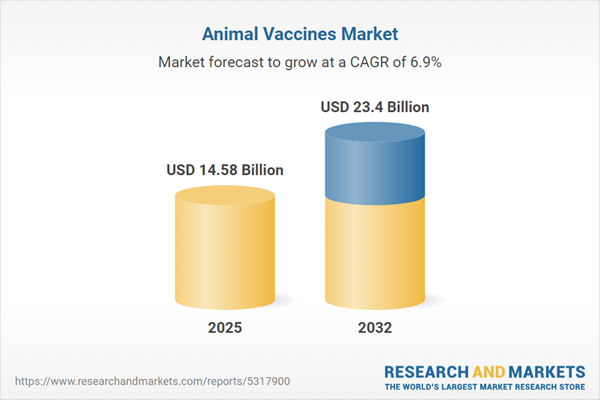Speak directly to the analyst to clarify any post sales queries you may have.
The animal vaccines market is experiencing dynamic change as new regulations, supply chain reconfigurations, and technological innovations influence industry priorities. Senior leaders in animal health organizations must continuously adapt to safeguard competitiveness and resilience in an evolving commercial and regulatory landscape.
Market Snapshot: Animal Vaccines Market Size and Growth
The animal vaccines market is forecast to increase from USD 13.69 billion in 2024 to USD 14.58 billion in 2025, yielding a 6.93% compound annual growth rate (CAGR). This upward momentum reflects expanding biotechnology investment, cutting-edge vaccine development techniques, and a renewed focus on robust supply networks for both companion and livestock animal health. Companies are strengthening disease prevention through cross-border collaboration and adapting strategies to address a diverse range of animal health needs. Strategic partnerships and operational flexibility support wider vaccine access, signaling an industry shift toward coordinated, integrated market approaches.
Scope & Segmentation: Animal Vaccines Market
- Product Types: Offerings include inactivated vaccines, live attenuated vaccines, mRNA vaccines, recombinant vaccines, and subunit vaccines, providing a comprehensive suite for targeted disease management within animal populations.
- Animal Types: Solutions cater to companion animals, such as dogs and cats, as well as livestock species including poultry, cattle, pigs, and sheep, aligning with the varied clientele of household and commercial agribusinesses.
- Disease Types: Vaccine portfolios address bacterial, viral, fungal, and parasitic threats, covering high-priority concerns like rabies, avian and swine infections, clostridial diseases, and E. coli. This ensures protective coverage adapts to regional and clinical risks.
- Route of Administration: Vaccines are delivered via intramuscular, intravenous, subcutaneous, and oral methods, enabling tailored intervention strategies for veterinarians and producers across settings.
- Distribution Channels: Access is widened through online pharmacies, veterinary clinics, and retail outlets, supporting timely product delivery and heightened availability for professionals and end users.
- Geographic Coverage: Demand and supply extend through the Americas, Europe, Middle East and Africa, and Asia-Pacific. Key economies, including the United States, China, India, Germany, Brazil, Japan, and Australia, influence regulatory standards and shape regional distribution frameworks.
- Key Company Profiles: Global leaders such as Biogénesis Bagó S.A., Zoetis Inc., Merck KGaA, Boehringer Ingelheim International GmbH, Ceva Santé Animale, VIRBAC, Elanco Animal Health Inc., Indian Immunologicals Limited, and Vetoquinol SA continue to drive innovation, expand offerings, and support market-wide progress.
Key Takeaways: Strategic Insights for Senior Leaders
- Adoption of mRNA and recombinant platforms enables animal health organizations to quickly address evolving disease profiles and safeguard business continuity.
- Digital traceability is delivering enhanced transparency within vaccine supply chains, reinforcing biosecurity and building trust among stakeholders.
- Staying aligned with changing regulatory frameworks is essential for effective risk oversight, particularly for global operations adapting to new compliance requirements.
- Broadening vaccine portfolios allows organizations to anticipate shifting regional needs, minimizing vulnerabilities to market fluctuations and volatility.
- Innovations in distribution bolster resilience, supporting uninterrupted supply amid unpredictable market conditions and fostering stronger partner networks.
- Investment in regional alliances and manufacturing supports rapid adaptation to evolving cost structures and compliance demands in priority geographies.
Tariff Impact: Navigating Cost and Regulation in Animal Vaccines
Tariffs affecting raw materials in the United States are prompting animal vaccine manufacturers to reconsider supply networks and production strategies. Developing regional manufacturing and establishing local partnerships enable organizations to offset increased input expenses while maintaining compliance. Strategic localization and robust risk management reinforce quality assurance and help companies navigate financial volatility and regulatory complexity.
Methodology & Data Sources
This report integrates expert interviews, a comprehensive literature review, and in-depth industry data analysis. All insights have been rigorously cross-verified to ensure strategic value for executive decision-makers within the animal vaccines market.
Why This Report Matters
- Supports data-driven investments in vaccine technology platforms and supply strategies, optimizing operations for companion and livestock market segments.
- Provides actionable frameworks to address regulatory challenges and organizational restructuring for consistent risk control at the leadership level.
- Enables senior executives to leverage digital and process improvements, equipping organizations to maintain competitiveness in an evolving animal health landscape.
Conclusion
Access to credible, timely market intelligence allows senior leaders to identify actionable opportunities and reinforce organizational strength. As innovation and regulation shape animal health, informed strategy remains central to advancing long-term performance.
Additional Product Information:
- Purchase of this report includes 1 year online access with quarterly updates.
- This report can be updated on request. Please contact our Customer Experience team using the Ask a Question widget on our website.
Table of Contents
3. Executive Summary
4. Market Overview
7. Cumulative Impact of Artificial Intelligence 2025
Companies Mentioned
The companies profiled in this Animal Vaccines market report include:- Biogénesis Bagó S.A.
- BioVaxys Technology Corporation
- Boehringer Ingelheim International GmbH
- Brilliant Bio Pharma Private limited
- Ceva Santé Animale
- China Animal Husbandry Industry Co., Ltd.
- Dalan Animal Health
- Elanco Animal Health Inc.
- Endovac Animal Health, LLC by Immvac Inc.
- Hester Biosciences Limited
- HIPRA, S.A.
- Indian Immunologicals Limited
- Kemin Industries, Inc.
- Merck KGaA
- Neogen Corporation
- Phibro Animal Health Corporation
- SAN Vet Holding GmbH
- Sanofi S.A.
- Seppic S.A.
- Torigen Pharmaceuticals Inc.
- Vaxxinova GmbH
- VEROVACCiNES GmbH
- Vetigenics, LLC
- Vetoquinol SA
- Virbac, Inc.
- Zoetis Inc.
Table Information
| Report Attribute | Details |
|---|---|
| No. of Pages | 180 |
| Published | November 2025 |
| Forecast Period | 2025 - 2032 |
| Estimated Market Value ( USD | $ 14.58 Billion |
| Forecasted Market Value ( USD | $ 23.4 Billion |
| Compound Annual Growth Rate | 6.9% |
| Regions Covered | Global |
| No. of Companies Mentioned | 27 |









